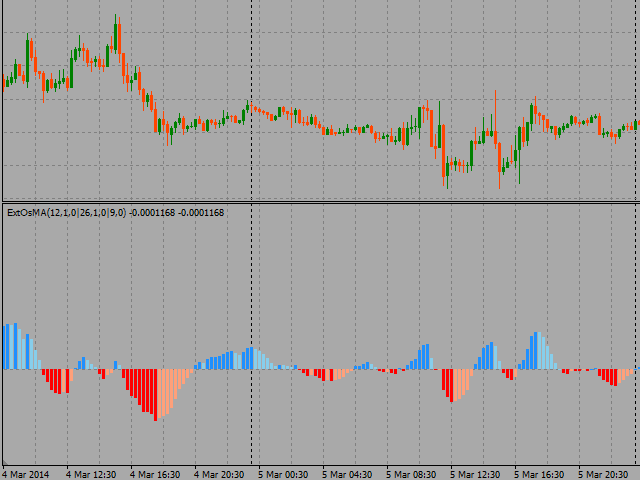An extended version of the OsMA indicator, colored in 4 colors (growth, fall above 0; growth, fall below 0). You can use 21 types of moving averages for each of the straight lines used, including for smoothing the final difference, and 11 price options for “fast” and “slow”.
Possible types of Averages: Simple Moving Average, Exponential Moving Average, Wilder Exponential Moving Average, Linear Weighted Moving Average, Sine Weighted Moving Average, Triangular Moving Average, Least Square Moving Average (or EPMA, Linear Regression Line), Smoothed Moving Average, Hull Moving Average by Alan Hull, Zero-Lag Exponential Moving Average, Double Exponential Moving Average by Patrick Mulloy, T3 by T. Tillson, Instantaneous Trendline by J. Ehlers, Moving Median, Geometric Mean, Regulated EMA by Chris Satchwell, Integral of Linear Regression Slope, Combination of LSMA and ILRS, Triangular Moving Average generalized by J. Ehlers, Volume Weighted Moving Average, Smoothing by Mark Jurik.
Calculation price options: Close, Open, High, Low, Median Price = (High Low)/2, Typical Price = (High Low Close)/3, Weighted Close = (High Low Close*2)/4, Heiken Ashi Close, Heiken Ashi Open, Heiken Ashi High, Heiken Ashi Low.
- PeriodFastMA – the period of the fast average;
- MethodFastMA – fast average smoothing method;
- PriceFastMA – used to calculate the fast average price;
- PeriodSlowMA – the period of the slow average;
- MethodSlowMA – method for smoothing the slow average;
- PriceSlowMA – used to calculate the slow average price;
- PeriodSignalMA – period of the signal line;
- MethodSignalMA – signal line smoothing method;
- AddDigits-an additional increase in the accuracy of the indicator readings in digits after the decimal point.





